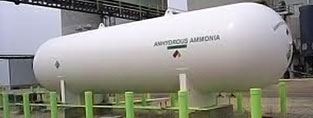
- (03) 5909 8218
- enquiry@fusionweld.com.au
Ammonia Plant Condensate Blowdown Vessel
June 14, 2017

Nitrogen and hydrogen are thrust together by chemically induced processes to produce large quantities of ammonia. Used as a fertiliser, the synthetically manufactured compound is also present in refrigerant gases and many other useful chemical products, including metal treatment reagents. The role of an ammonia plant condensate blowdown vessel in this processing chain is to supply these large quantities of liquid ammonia, so let's talk about this special vessel type.
Feedstock Extraction Basics
If the "Nitrogen Cycle" is to be maintained, the agricultural sector is expected to acquire large amounts of this gaseous element. Of course, nitrogen makes up seventy-eight percent of our atmosphere, but it isn't naturally absorbed into the soil. Instead, we use ammonia-based (NH3) fertilisers, which means a volatile source of hydrogen must be secured. This explosive gas is stored in tanks, chemically released from light hydrocarbons, and generally extracted from commonly landlocked gases. As for the nitrogen, that's right there, in the atmosphere.
Processing Ammonia Plant Condensates
Extracted from coal or naphtha, natural gas or asphalt, the hydrogen extract combine with nitrogen in a fixed bed reactor. Catalysts and heat and pressure facilitate chemical reactance, at which point the mix is exposed to a series of fluid absorption cells and a special N2 washdown procedure. The condensate blowdown vessel hosts these complex mechanical innards while providing a reinforced vessel lining that endures despite the presence of numerous catalysing agents and scrubbing assemblies. Essentially, the pressurised "blowdown" stream is washed free of contaminants as it condensates, then the compound is further enriched by passing the liquid through a nitrogen-dense bath.
Blowdown-Capable Modular Vessel Designs
The stout vessel profile is loaded with inner assemblies, so exterior ports and instrumentation connections are typically provided. Blowdown, as the term implies, is a dynamic force that arises when great pressures are applied, so the vessel design, although loaded with precisely engineered parts, must be designed to withstand substantial transient loads. After all, that flushing action is driving forward several combustible liquids, plus CO, CO2, and a few accelerated contaminant streams, all of which will be scrubbed clean after further chemical processing.
Blowdown tanks are commonly employed in boiler systems. Ammonia plant condensate blowdown vessels, however, are primarily used in large chemical processing facilities, the kind of industrial sites that store natural gas and other hydrogen-rich materials. As such, great design acuity and superior manufacturing skill are mandated here, for these monolithic chambers are working with explosive gases to produce ammonia, a compound that's undoubtedly useful but also capable of causing harm.
Contact Details
Fusion - Weld Engineering Pty Ltd
ABN 98 068 987619
1865 Frankston Flinders Road,
Hastings, VIC 3915
Ph: (03) 5909 8218
Optimized by NetwizardSEO.com.au
Recent Posts
- Compressed Hydrogen Storage Vessels: Material Selection, Design & Australian Standards
- Welding QA/QC in Oil & Gas Pressure Vessel Fabrication – Ensuring Code Compliance
- AS1210 vs ASME VIII Pressure Vessel Code: Key Differences for Australian Projects
- Mitigating Hydrogen-Induced Cracking in Pressure Vessels: Engineering and Material Strategies
- Storage Tank Solutions Australia: Field-Erected, Prefabricated & Self-Bunded Explained
- Reducing Environmental Risks: Self-Bunded Tanks in Australian Oil & Gas Operations
- Precision in Production: How Pressure Vessels Are Manufactured for Industrial Safety
- Shell & Tube Heat Exchangers: Improve Thermal Control & Energy Recovery in Petrochemical & Pharmaceutical Plants
- In-Service Inspection for Compressed Air Receivers for Power Plant Shutdown Prevention
- Power Plant Pipe Spooling Fabrication – Get Rapid, Code-Compliant Spools Ready for Installation
- Field Erected Tanks: Safe, Reliable On-Site Fuel Storage Solutions in Australia
- Custom Pressure Vessel Fabrication for Flammable Gases
Posts 2025
- Compressed Hydrogen Storage Vessels: Material Selection, Design & Australian Standards
- Welding QA/QC in Oil & Gas Pressure Vessel Fabrication – Ensuring Code Compliance
- View all articles…
Posts 2024
- Large Process Vessels: Optimising the Design for Maximum Efficiency [2025]
- Pressure Equipment Management System Installation: Detect Equipment Faults Early
- View all articles…
Posts 2023
- Pressure Piping System Inspection: A Gift of Safety for the Holidays
- Deaerator Inspections by Fusion-Weld Engineering and How They Reduce System Downtime
- View all articles…
Posts 2022
- How Fusion Weld Keeps Up With AS-NZS ISO 9001:2008 Standard
- Boiler Equipment Safety Inspection During the Summer Season
- View all articles…
Posts 2021
- Avoid These Factors and Practices that Contribute to Sealing Damage in Pressure Vessels
- Do's And Don'ts Of Industrial Boiler Inspection And Maintenance From Fusion-Weld
- View all articles…
Posts 2020
- What are the Risks and Hazards Involved in Pressure Vessel Equipment?
- How to Know if Your Pressure Equipment Needs Repair or Replacement?
- View all articles…
Posts 2019
- Factors that Contribute to Pressure Vessel Failure
- Pressure Vessel Regulations in Australia: What are the Mandatory Requirements?
- View all articles…
Posts 2018
- Pros and Cons of Spherical vs. Cylindrical Pressure Vessels
- What are the Different Hazard Levels in Pressure Vessels?
- View all articles…
Posts 2017
- Transportable Pressure Vessels: The Importance of Inspection and Safety Checks
- Fracture Mechanics and Stress Analysis of Cracks in Pressure Vessels
- View all articles…
Posts 2016
Posts 2015
- What Are Deaerators & Feedwater Vessels?
- Precautions and Safety for Compressed Air Receiver Vessels
- View all articles…
Posts 2014
- Demonstrating In-process Inspection Procedures
- Static Grounding Practices and Standards
- View all articles…